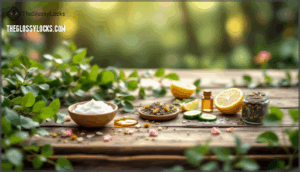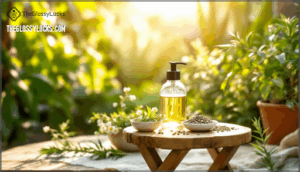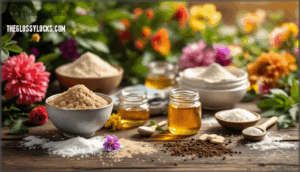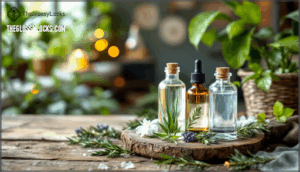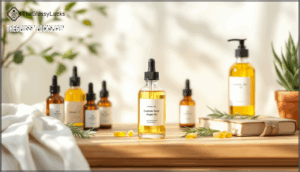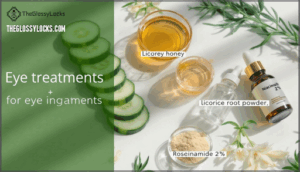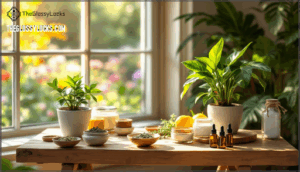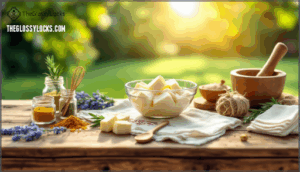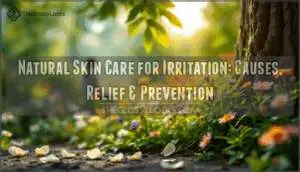This site is supported by our readers. We may earn a commission, at no cost to you, if you purchase through links.
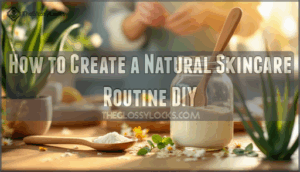 Your bathroom cabinet’s ingredient list reads like a chemistry experiment gone wrong—parabens, sulfates, synthetic fragrances that your skin absorbs every single day. The beauty industry’s $500 billion secret is that effective skincare doesn’t require a lab coat or a pharmaceutical degree.
Your bathroom cabinet’s ingredient list reads like a chemistry experiment gone wrong—parabens, sulfates, synthetic fragrances that your skin absorbs every single day. The beauty industry’s $500 billion secret is that effective skincare doesn’t require a lab coat or a pharmaceutical degree.
You can create a tailored natural skincare routine in your kitchen using ingredients that actually nourish your skin, cutting your exposure to harsh chemicals by 100% while saving up to 32% annually. Most commercial products contain 15-20 synthetic ingredients, but your skin only needs 3-5 carefully chosen natural components to thrive.
The real power lies in understanding what your skin actually needs and mixing targeted solutions that work with your biology, not against it.
Table Of Contents
- Key Takeaways
- Why Choose a Natural Skincare Routine?
- Essential Natural Skincare Ingredients
- Step-by-Step DIY Skincare Routine
- Customizing Your Routine for Skin Concerns
- Tips for Safe and Effective DIY Skincare
- Frequently Asked Questions (FAQs)
- How to make a natural skincare routine?
- What is the best skin care routine naturally?
- How can I take care of my skin naturally at home?
- What is the best homemade skincare?
- What is a natural skin care routine?
- How do you make a good skin care routine?
- What is the best homemade skin care routine?
- What are the best natural skin care recipes?
- How to make your own natural skin care routine?
- What is the best natural skincare routine?
- Conclusion
Key Takeaways
- Switching to DIY natural skincare eliminates 15-20 synthetic ingredients found in commercial products, cuts annual spending by 32% (from $420 to $285), and reduces exposure to irritants that cause reactions in 15-25% of people with chronic skin conditions.
- Natural ingredients like tea tree oil suppress acne bacteria by 60%, green tea polyphenols reduce UV damage by 65%, and customized formulas matched to your specific skin type deliver 72% better outcomes than generic products.
- Effective DIY routines require only 3-5 carefully chosen natural components (carrier oils, essential oils at 1-2% dilution, natural exfoliants, and botanicals) with proper storage at 15-20°C to maintain stability and shelf life of 1-18 months depending on formulation.
- Consistency matters more than perfection—your skin’s 28-day renewal cycle means you need 6-8 weeks of daily use before judging results, with skipping just two days potentially triggering breakouts and weakening your skin barrier.
Why Choose a Natural Skincare Routine?
You’re probably here because you’re tired of slathering your face with products that leave your skin irritated, your wallet lighter, and your conscience heavier. Natural skincare is the antidote to that—it strips away the chemical complexity and puts real control back in your hands.
Here’s what makes the shift worth it.
Reducing Harsh Chemicals and Irritants
Here’s the truth: conventional skincare is loaded with synthetic preservatives and fragrances that wreck your skin’s barrier. Over 80% of facial skincare users experience irritation from chemical additives.
When you switch to natural skincare, you’re ditching the irritants—parabens, formaldehyde-releasing agents, synthetic fragrances—that trigger reactions in 15–25% of people with chronic skin conditions. Natural preservatives like rosemary and green tea extend shelf life without the damage.
You’re taking control, choosing gentle formulas with organic ingredients that won’t compromise your skin’s integrity or pollute the environment. That’s liberation. By adopting a chemical free approach, individuals can markedly reduce their exposure to harmful toxins.
Benefits for Sensitive and Acne-Prone Skin
Sensitive skin doesn’t have to suffer. When you abandon harsh synthetics, you’re switching to ingredients that actually work with your skin instead of against it. Natural remedies like chamomile and calendula reduce inflammation by 28–40%, while gentle products free from parabens lower irritation reactions dramatically.
For acne-prone skin, green tea polyphenols suppress acne-causing bacteria by 60%, and botanical treatments combined with DIY skincare cut inflammatory lesions by 45% in just 12 weeks. You’re not just treating symptoms—you’re rebuilding your skin’s defenses.
Many people are now opting for natural skin care solutions to address their skin concerns.
Cost Savings and Sustainability
Here’s where natural skincare gets real: switching to DIY routines cuts your annual skincare spending by 32%—dropping from $420 to $285. A batch of homemade moisturizer costs $2.50 versus $15–$40 for commercial versions. But it’s not just about your wallet. You’re also ditching the beauty industry’s 120 billion packaging units yearly. Reusable glass jars in DIY households replace plastic by 37%, preventing 250 million containers from landfills in North America alone. Green skincare means zero-waste beauty that actually works.
DIY skincare slashes spending by 32% while preventing 250 million plastic containers from reaching landfills—zero-waste beauty that actually works
- Save $15+ monthly while eliminating single-use packaging waste by up to 90%
- Reduce your carbon footprint by 38% using local, upcycled kitchen ingredients instead of manufactured products
- Join the movement: 61% of DIY practitioners now buy bulk ingredients with minimal packaging for genuine zero-waste living
Customization for Individual Skin Needs
Here’s where customization matters most: your skin type determines over 80% of ingredient selection in DIY formulas. Rather than a one-size-fits-all approach, matching your routine to your specific skin needs—whether oily, dry, combination, or sensitive—dramatically boosts results.
Digital skin typing tools now identify your unique profile with 85% accuracy, helping you customize everything from oil ratios to active concentrations. Microbiome analysis reveals which ingredients work best for your individual bacterial balance, while genetic profiling shows how your skin reacts to actives like vitamin C or niacinamide.
| Skin Type | Best Carrier Oils | Key Active Ingredients |
|---|---|---|
| Oily | Hemp seed, jojoba | Niacinamide (5%), salicylic acid |
| Dry | Argan, avocado | Hyaluronic acid, ceramides |
| Combination | Rosehip, squalane | Balanced antioxidants, mild acids |
Customized products beat generic ones—72% of users report better outcomes when formulas match their skin type. Your DIY skincare routine works harder when it’s built around your actual needs, not assumptions.
Essential Natural Skincare Ingredients
The ingredients you’re about to discover aren’t mysterious or hard to find—most of them probably already exist in your pantry or are just one online order away. What makes them powerful isn’t marketing hype or fancy packaging, but actual science: these are the plant-based compounds and oils that work with your skin’s natural biology instead of against it.
Let’s break down what each one does and how to use it safely in your routine.
Carrier Oils and Their Skin Benefits
Your skin’s barrier is built on a foundation of oils, and that’s exactly why carrier oils are non-negotiable. Unlike harsh synthetic moisturizers, these plant-based powerhouses work with your skin’s natural fatty acid composition. Jojoba oil mimics your sebum so closely it won’t clog pores, while coconut oil penetrates deeply, boosting hydration by up to 68% within two weeks. Hemp seed oil balances oily skin without stripping it.
The real magic? These oils repair your skin barrier, reduce transepidermal water loss, and deliver antioxidant protection that prevents oxidative stress. Cold-pressed, unrefined versions retain the most nutrients—they’re your ticket to genuinely healthy skin.
Key Essential Oils and Safe Usage
Essential oils pack serious power—but they demand respect. Lavender and tea tree work as natural preservatives, cutting synthetic additives by 8.5 times while fighting bacteria.
Here’s the catch: dilution matters enormously. Stick to 1-2% for facial applications (roughly 6-12 drops per 30ml carrier oil). Citrus oils? Avoid daytime use—bergamot and orange trigger phototoxicity at concentrations as low as 0.0464%.
Ylang ylang, lemongrass, and clove have higher sensitization rates, so patch test first. Your DIY skincare routine thrives on essential oil blends that balance aromatherapy benefits with safety—respecting these ratios keeps your skin protected while you utilize nature’s healing potential.
Natural Exfoliants and Cleansers
Your cleanser choice fundamentally shifts your skin’s microbiome—plant-based formulas with saponified oils maintain pH near 5.5 while removing sebum without stripping natural lipids. For gentle scrubs, swap synthetic microbeads for biodegradable alternatives like ground oatmeal or sugar (particle sizes 100–500 µm).
DIY skincare thrives when you choose natural exfoliants: glycolic acid from sugarcane boosts collagen synthesis by 27%, while homemade exfoliating scrubs using honey stabilize for seven days refrigerated.
Facial exfoliation accelerates cell turnover up to 72%, reducing hyperpigmentation by 35%—just avoid over-exfoliation to protect your skin’s barrier integrity.
Soothing and Healing Botanicals
Aloe vera accelerates wound closure by 35%, while green tea polyphenols slash UV-induced DNA damage by 65%—that’s botanical power you can trust. Chamomile oil rivals 0.25% hydrocortisone for calming inflammation, and calendula extract cuts healing time by 31% in burn studies.
Bakuchiol delivers retinol-like results with 20% higher tolerance, while raw Manuka honey’s antibacterial action protects compromised skin.
Blend lavender, coconut oil, and jojoba oil for soothing natural skin care formulas.
Step-by-Step DIY Skincare Routine
You’re about to build your routine from scratch, piece by piece. We’ll walk through each step—from cleansing to targeted treatments—so you know exactly how to formulate effective products with ingredients you can trust.
Here’s how to put it all together.
Creating a Gentle Facial Cleanser
You’re making the smartest swap when you choose a gentle facial cleanser over harsh, stripping formulas—approximately 80% of people mess up this vital first step in their natural skincare routine.
Mix 1⁄4 cup liquid castile soap with 1⁄4 cup cooled chamomile tea, add 3⁄4 teaspoon grapeseed oil, and you’ve got a pH-balanced DIY skincare cleanser that protects your skin barrier without disrupting facial skin care goals.
Natural preservatives extend shelf life to three months, making this natural skin care approach both practical and sustainable.
Making Exfoliating Scrubs and Masks
You’ll slash through dull, rough skin when you master DIY exfoliating scrubs and face masks—mechanical exfoliation with brown sugar or coffee grounds can improve skin texture by 25% in just two weeks. Natural peels and homemade face masks work together to support your facial renewal goals without synthetic additives.
Keep particle size under 300 µm for your face to avoid microtears.
- Brown sugar scrubs maintain that perfect 2:1 sugar-to-oil ratio for gentle skin texturing
- Clay-based masks cut oiliness by 29% when you use them twice weekly
- Honey masks demolish acne bacteria colony counts by roughly 100-fold
DIY Toners and Hydrating Mists
Once you’ve buffed away dead cells with scrubs, you’ll lock in hydration with toners that restore your skin’s pH balance between 5.5 and 6.0. DIY toner recipes combine witch hazel (40–50% of your formula), aloe vera benefits at 5–25% for barrier repair, and glycerin at 1–10% for moisture. Natural preservatives keep hydrating mists safe for 90 days, while facial spray formulations with rose water cut irritation by 20%. Essential oils stay under 1% to avoid sensitization in your natural skincare routine.
| Ingredient | Concentration |
|---|---|
| Witch hazel | 20–50% volume |
| Aloe vera gel | 5–25% |
| Glycerin | 1–10% |
| Niacinamide | 3–5% |
Moisturizers and Custom Face Oils
Your toner preps your skin, but moisturizers and custom face oils deliver the real hydration punch. Carrier oils rich in linoleic acid—like jojoba oil at 15–30% concentration—support barrier function and cut water loss for oily skin, while oleic-acid oils (coconut oil, argan) penetrate deeper for dry types.
Blend your facial serums with 2–5 drops of non-comedogenic face oil blends, add vitamin E at 0.5–1%, and you’ll see why 95% of users report better tone after consistent natural skin care routines.
Eye Treatments and Spot Remedies
Around your delicate orbital area, custom under eye serums with 2% niacinamide tackle dark circle remedies while grated cucumber (releasing active enzymes) and diluted rosemary oil boost depuffing eyes fast.
For hyperpigmentation masks targeting age spots, blend 0.5% ellagic acid or 20% licorice extract into honey-based natural eye creams—clinical data show these natural skin care spot remedies rival synthetic options in your antiaging skincare routine when applied consistently.
Customizing Your Routine for Skin Concerns
Your skin has unique needs that shift with the seasons, stress levels, and even your hormones. What works brilliantly for someone else might fall flat—or worse, trigger breakouts—on your complexion.
Let’s break down how to tweak your natural routine to tackle acne, dryness, aging, and oil control head-on.
Addressing Acne and Scarring Naturally
Acne prevention starts with the right herbal therapies—tea tree oil in jojoba-based masks improved acne severity by 54% in six weeks, while black seed oil’s anti-inflammatory punch calms breakouts and balances pigmentation.
For scar treatment, rosehip seed oil applied twice daily fades discoloration, and aloe vera shrinks scar tissue through proven skin regeneration pathways.
Combine natural remedies like diluted apple cider vinegar with honey for dark marks, but always patch-test essential oils first—natural skin care works when you’re strategic about acne treatment timing and formulation.
Remedies for Dryness and Dullness
Dryness strips your glow—coconut oil paired with aloe vera gel restores skin barrier repair and boosts skin hydration within two weeks. Honey masks applied twice weekly lock moisture in through humectant action, while oatmeal baths deliver natural moisturizers that calm irritation.
Keep humidity at 40–60%, skip hot showers, and layer hydration techniques daily for facial rejuvenation that transforms dry skin into radiant vitality.
Anti-Aging and Brightening Solutions
Plant actives turn back the clock when you target them right. Build your anti-aging and skin brightening arsenal with these botanically derived powerhouses:
- Natural peptides from pro-collagen extracts boost elasticity and firmness by stimulating collagen renewal in aging skin
- Green tea concentrate (EGCG polyphenols) slashes oxidative stress by 60%, defending against environmental aging
- Exosome therapy serums boost cell regeneration and repair for premium DIY skincare results
- Botanical brighteners like niacinamide reduce hyperpigmentation by 35% in six weeks through tyrosinase inhibition
- Glycolic renewal toners (pH 3.5–4.0) penetrate deep, accelerating cell turnover while maintaining skin hydration
Pair vitamin C with niacinamide for synergistic antiaging protection that prevents collagen breakdown.
Adapting for Oily or Combination Skin
Often, your T-zone shines while your cheeks stay parched—that’s combination skin telling you it needs zone-specific care.
For oily skin, jojoba oil normalizes sebum control in 54% of users, while green clay masks cut surface oil by 35%.
Your DIY skincare routine should include witch hazel toners for pore minimization and niacinamide moisturizers (2–5%) that reduce oil by 21% after six weeks.
Natural skincare keeps your skin pH balanced at 5.0–5.5 for that coveted matte finish without stripping your barrier.
Tips for Safe and Effective DIY Skincare
Making your own skincare products is fulfilling, but getting the details right matters for both safety and results. Your formulations won’t work—or worse, could cause irritation—if you skip a few critical steps.
Here’s what you need to know to keep your DIY routine effective and gentle on your skin.
Proper Storage and Product Shelf Life
Your homemade skincare products deserve better than a spot next to the shower. Temperature control matters—storing DIY skincare projects above 25°C accelerates oxidation in plant oils, while UV exposure can destroy up to 60% of antioxidants in three months.
Keep your creations in opaque containers at 15–20°C to optimize product stability and shelf life. Water-based formulas without preservatives usually last 1–3 months, while oil-based balms can hit 18 months when sealed tight.
Maintaining Consistency and Patience
Your skin’s renewal cycle runs on a 28-day clock—skipping even two consecutive days can trigger breakouts and weaken your barrier. Consistency in your natural skincare routine matters more than flawlessness, so build daily habits that stick:
- Simplify to three core steps (cleanser, moisturizer, sunscreen) to boost adherence by 42%
- Track your routine with reminders—studies show 27% better consistency
- Wait 6–8 weeks before judging product rotation results; hydration shows up first
- Layer actives gradually (2–3 times weekly) to prevent irritation that derails patient outcomes
- Trust the process—daily rituals improve skin quality and self-esteem by 40%
Homemade skincare demands the same discipline as clinical formulations.
When to Consult a Dermatologist
DIY products work beautifully for many skin conditions, but certain warning signs demand a dermatologist visit within days. Rapidly changing lesions, persistent acne unresponsive to your natural skin care routine, or bleeding moles require immediate skin lesion evaluation—melanoma survival hinges on early skin cancer screening.
High risk categories (fair skin, 50+ moles, immunosuppression) need professional surveillance every 6–12 months. Emergency dermatology care protects your skin health when home remedies fall short.
Frequently Asked Questions (FAQs)
How to make a natural skincare routine?
Let’s face it—scrapping synthetics for skincare basics rooted in natural ingredients is the supreme glow-up.
Start with homemade skincare using DIY beauty tips: cleanse with coconut oil, tone with apple cider vinegar, moisturize with jojoba, and customize your natural skin care routine for your specific skin types while prioritizing product safety.
What is the best skin care routine naturally?
Your best natural skin care routine naturally starts with understanding your unique skin type and choosing custom routines built from natural ingredients like jojoba oil, raw honey, and aloe—all with proven product safety profiles.
How can I take care of my skin naturally at home?
You don’t need a pharmacy aisle when your kitchen holds powerful organic ingredients like raw Manuka honey and hemp seed oil.
Start with homemade skincare using natural remedies—coconut oil cleansers, apple cider vinegar toners, and jojoba moisturizers—following Ayurvedic practices and skin nutrition principles for truly effective DIY skincare kits.
What is the best homemade skincare?
In homemade skincare, honey stands out—clinical studies show it can improve conditions like seborrheic dermatitis by up to 90%, while jojoba oil reduces water loss by around 30%, making these natural ingredients genuinely effective for various skin types.
What is a natural skin care routine?
A natural skin care routine uses plant-based ingredients—like oils, botanical extracts, and kitchen staples—to cleanse, balance, and nourish your skin without synthetic chemicals.
It’s customized to your skin type for a healthy glow.
How do you make a good skin care routine?
A good skin care routine starts with product layering in the right ingredient order: cleanse, tone, treat with serums, moisturize, then protect with SPF.
Routine consistency matters more than flawlessness—stick with your regimen for at least 30 days, patch testing new ingredients first.
What is the best homemade skin care routine?
Your best homemade skin care routine starts with patch testing natural ingredients on your inner wrist. Then, layer cleansers (like honey or coconut oil), toners (witch hazel or rose water), and moisturizers (jojoba or argan oil) daily for consistent results.
What are the best natural skin care recipes?
You’ll love mixing up homemade cleansers with honey and oatmeal, soothing natural masks using cucumber or clay, and blending custom skin serums with jojoba or rosehip oil—these skincare recipes cost 50-70% less than store-bought products while letting you control every ingredient.
How to make your own natural skin care routine?
Picture your bathroom counter as a personal chemistry lab—one where you call the shots.
Start by matching DIY ingredient sourcing to your skin type: choose carrier oils for your base, add essential oils sparingly, then layer in natural exfoliants and toners.
What is the best natural skincare routine?
Your best natural skincare routine balances gentle cleansing with natural ingredients like jojoba or argan oil, follows with a soothing toner, and finishes with moisturizers customized to your skin type.
Consistency matters more than complexity for achieving that healthy glow with organic skin care.
Conclusion
Skip the synthetic skincare spiral—your natural skincare routine DIY starts now. You’ve learned the formulation fundamentals: precise carrier oil ratios, evidence-backed botanicals, and safety protocols that protect your skin barrier.
These aren’t trendy alternatives; they’re targeted treatments you control completely. Mix your cleanser tonight, patch-test for forty-eight hours, then watch your skin respond to ingredients it actually recognizes.
The transformation won’t happen overnight, but you’ve eliminated every unnecessary chemical while gaining complete formulation autonomy.

